Operating Systems Lecture Notes
2014 October 23 • Segmented and Paged Storage
Outline
- Segmentation
- Paging
Relocation Illustrated
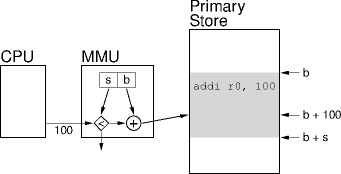
Areas of Interest
- A process’s address space regions have different access
behaviors.
- Code is read and executed, but not written.
- Data are read and written, but not executed.
- Global data are static read-write.
- Constant data are static read-only.
- Heap and stack data are dynamic read-write.
- Distinguishing these regions opens up opportunities.
Process Segments
- Segments are address-space regions of uniform access behavior.
- Segments can be packed into a contiguous address space.
- Or the address space can be a set of segments.
|
|
|
Segment Addresses
- Contiguous segments use relocatable (base + offset) addresses.
- Noncontiguous segments also use relocatable addresses, but each
segment has a different base and limit.

|
|
|
Segment Addressing
- The MMU becomes a set of segmentation registers, one per
segment.
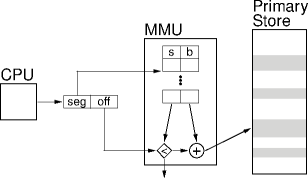
Segment Allocation
- Each address-space segment is allocated as usual.
- Simpler because smaller, but more of them.
- Noncontiguous segments can use noncontiguous allocation.
- Dynamic (on-demand) segment loading doesn’t load unused segments.
- MMU segmentation register look-up fails.
Access Protection
- Segments are tagged with the allowed access types.
- Reading, writing or executing.
- Access-type bits added to the segment registers.

- CPU issues logical addresses and access types.
- Mismatches in issued and allowed access types cause a protection violation.
Dynamic Segments
- Increasing a segment’s size is straightforward.
- Move the segment to a larger free-space chunk.
- Adjust the segment’s base and limit registers.
- If the segment’s adjacent to a large-enough free-space chunk, skip step 1.
- Contiguous address spaces can be adjusted in the same way.
- With more copying.
Size-Change Examples
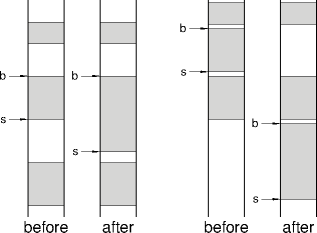
Segment Problems
- The segment-count/segment-size trade-off can be tricky.
- Many small segments or few huge segments.
- More allocations per process.
- More smaller allocations promote external fragmentation.
- Handling segmented addresses is tricky and inconvenient.
- Swapping gets messy and more inefficient.
Improving Segments
- Noncontiguous is good: non-picky allocation.
- Variable size is bad: too much housekeeping and overhead.
- Split the difference: use fixed-sized segments called pages.
- Pages are small, from 512 bytes to low Mbytes.
- Typically low kbytes — 1, 2, 4 kbytes.
- A process’s address space is an integral number of fixed-sized pages.
Paged Primary Store
- Primary store is divided into page-sized slots called page frames.
- Page allocation is trivial: use any open page frame.
- Allocate off the head of the page-frame free list.
- External fragmentation disappears.
- Or rather, is replaced by internal fragmentation.
Paged Addressing
- Paged addressing is just like segmented addressing.
- Just change “segment” to “page”.

- Just change “segment” to “page”.
- The segment registers become the page table, a mapping from page numbers to page frames.
Page Addressing Example
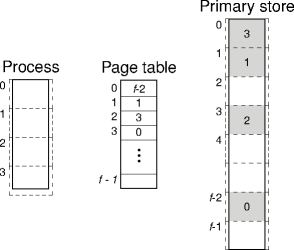
MMU in Paging
- The MMU still translates logical to physical addresses.
- Using the page table instead of segment registers.
- Pages and page-table entries can be tagged with access bits.
- May induce more internal fragmentation.
- Per-segment length checks are gone.
Page Count Problems
- Large (Gbyte) primary stores and small (kbyte) pages lead to large page tables.
- 2 Gbyte/2 kbyte = 220 ≈ 106 page-table entries.
- Megabyte-capable MMUs are way too expensive to contemplate.
- Even modestly sized page tables are too expensive to swallow whole.
- How should large page-table sizes be handled?
Large Page Tables
- If the page table can't fit in the CPU, it has to go in primary store.
- The CPU page-table register points to the page table.
- Each access takes two accesses.
- One for the page-table access, the second for the access.
- Doubling storage access time is unacceptable. How to fix?
Caching
- Remember (page number, page frame) pairs on-chip.
- When mapping, look on-chip first, then go to the page table if needed.
- (Number, frame) pairs are stored in a fast, small, associative on-chip
cache.
- The translation look-aside buffer (TLB).
- Fast: single-digit cycles; small: 4 to 256 entries.
- Associative: parallel search.
Page Protection
- Pages can be tagged with access (rwx) bits.
- Page-table entries contain allowed accesses.
- Page-table entries may also have a validity bit.
- No frame for this page.
- Illegal access past the ends.
- Holes in the process address space.
Sharing Pages
- Two or more processes can map the same page frame into their address
spaces.
- The resulting pages are shared among the processes.
- Processes can use shared pages for IPC.
- OSs can use page sharing to share common code among processes.
- Page-table hacks are fun and fast.
- The results are usually fun and fast too.
Sharing Example
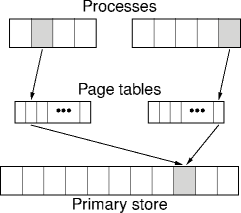
Big Store
- Modern address spaces can be huge, 248 (≈ 1014) to 264 (≈ 1019) bytes.
- The resulting page tables are ridiculously large, even for process
address spaces.
- 248/212 = 236 ≈ 64 billion entries.
- Not too large for primary store, but otherwise useless.
- What happens when address spaces get huge?
Paging Hierarchy
- When the page table gets too large, cut it down to size.
- Turn a 48-bit address space into a set of 4G (232) chunks.
- There are 248/232 = 216 ≈ 64k chunks.
- The result is a hierarchical page table.
- The root page table indexes leaf page tables.
- Each leaf page table handles a 4G chunk.
- Repeat as needed (or until comfortable).
Hierarchy Example
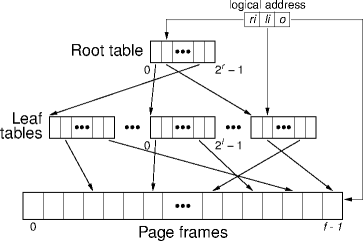
Hashed Page Tables
- Replace the page table with a hash table.
- Hashed page-number keys.
- The bucket values are page frames.
- Collisions resolved by matching page numbers.
- Clustering groups page numbers into a single bucket.
- Good when the process address space is sparse.
Hash Table Example
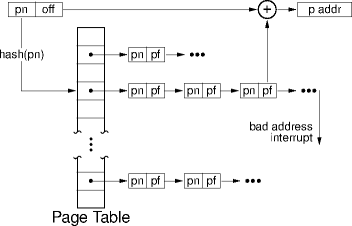
Fun Facts
- Physical store is smaller than logical store.
- Physical store was rarely 232 and is never 248 or 264 bytes.
- Far fewer page frames than pages.
- There is one page frame i, but many page is.
- As many page is as processes.
- And as many page tables.
- So what?
Inverted Page Tables
- Use page-frame numbers as page-table indices, not page numbers.
- An inverted page table.
- An entry is a (proc. id, page no) pair, or is empty.
- There is one inverted page table, not one per process.
- No context-switch overhead.
- An inverted page table is smaller than a page table.
Inverted Table Example
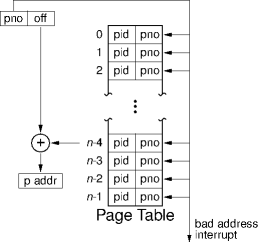
Summary
- Segments recognize regions of common process access.
- Segment allocations provides flexibility and convenience.
- Pages are fixed-sized segments, independent of use.
- Pages generalize segment flexibility.
| This page last modified on 2014 October 25. |


